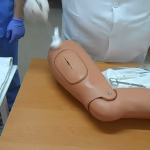 Primary debridement (PSW)
Primary debridement (PSW)
 Primary surgical treatment of a wound is a surgical operation that must be performed in a medical and preventive institution by a doctor with the qualifications of a surgeon. The goal is to exclude suppuration of damage and create conditions for speedy healing.
Primary surgical treatment of a wound is a surgical operation that must be performed in a medical and preventive institution by a doctor with the qualifications of a surgeon. The goal is to exclude suppuration of damage and create conditions for speedy healing.
Types of wounds
All wounds, except those inflicted with a sterile instrument under aseptic conditions, are classified as primary infected wounds and are subject to mandatory treatment with an antiseptic and dressing.
Depending on the mechanism of application, wounds are divided into cut, stab, bruised, lacerated and gunshot wounds. If the damage affects the cavities of the body (abdominal, thoracic), they speak of a penetrating wound. The surgical intervention algorithm is determined based on the type, localization of injuries and the type of damaged tissues.
Technical equipment and a set of tools.
Primary surgical treatment should be carried out under aseptic conditions (operating room, dressing room).
Surgical instruments: Toe caps, scalpel (pointed and belly), Frabeuf hooks, hemostatic forceps (Kocher and Billroth), tweezers (anatomical and surgical), straight and curved forceps, scissors (straight and curved, blunt and pointed), syringes and games , surgical needles, cutting, curved, suture material (lysing and non-lysing), Deschamp's ligature needle, Volkmann's spoon, probes (button, grooved).
Stages of PST
Disinfection of damage (using a gauze sponge soaked in ethyl solution or a similar agent to clean the edges of the damage, remove foreign bodies, treat the damaged area with an antiseptic and bandage it with a sterile bandage).
With abrasions and superficial cuts, PXO is completed at this stage. In other cases, the opening of damaged areas, in compliance with all norms and rules, entails the speedy healing under the sutures by primary intention (opening, cutting the marginal places and the entire depth of damage within healthy skin, removing dead tissue). Next, the wound cavity is carefully examined for the presence of blind pockets. Before suturing, be sure to stop the bleeding, if any. For this, large vessels are tied or sutured. The suturing of the bottom and walls of healthy tissues is performed in layers to restore the anatomical integrity of the site. Cavities are not allowed. Opening the damaged area, with tissue cutting creates the possibility of speedy healing by repeated tension, the damage is tightly sutured in turn with several layers. With the threat of infection, a drain is installed. The final step is the treatment with an antiseptic and the application of a sterile bandage. Regardless of the severity of the damage, an injection of tetanus toxoid is performed, and for animal bites, an anti-rabies vaccine is performed.
For clarity, watch the video: